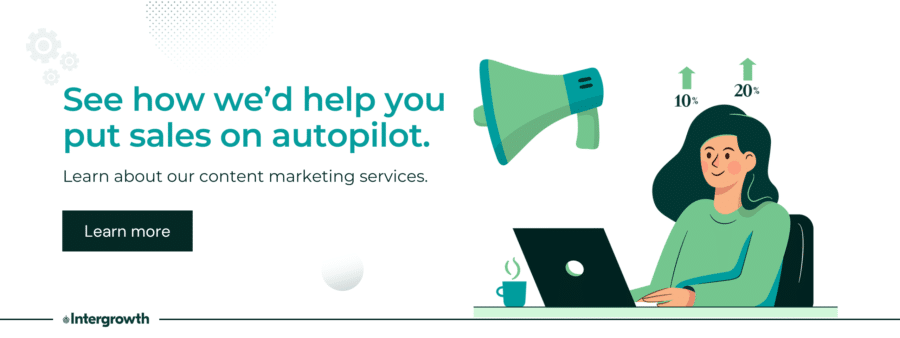Our team creates content strategies that drive results for our clients. We’ve defined what a top-tier content strategy looks like, and I’ll share our framework in this article.
But first …
How do most content marketing agencies build content strategies?
Most agencies take a very similar approach to building content strategies:
- finds topics about the client’s industry
- conducts keyword research to see which topics have high search volumes
- runs a content audit to see which topics already exist on the client’s site
- removes keywords with high keyword difficulty scores
- adds all remaining topics to the editorial calendar
And that’s it — their 12-month content plan is done.
So what’s the issue here?
We have two issues with this approach. This strategy assumes that:
- All keywords have equal value.
- Search terms with low search volume aren’t worth writing about.
And those just aren’t true.
So How Do You Build a Better Content Marketing Strategy?
Over the past five years, we’ve written thousands of articles, and we’ve learned a lot about what makes a great content strategy.
A successful long-term content strategy includes five different types of content:
1. Awareness Content
Awareness content, or top-of-funnel content, focuses on driving more visibility for your brand. These articles are about topics that are no more than one degree removed from what you do as a business.
This type of content won’t directly drive sales. However, these articles are valuable resources that other blogs link to and share with their readers. The backlinks you receive steer search authority back to your article, as well as each page that your article links to.
We identify Awareness Content topics through data-driven keyword research. These articles are optimized for search engines, which can help them to rank in the highest positions on Google for dozens of keywords. That way, when your target audience searches online for information about their pain points, they’ll be steered toward your website.
Great content agencies understand that they can hire talented writers, train them to be grade-A researchers, and coach those writers to deliver a great version of these types of articles.
The resulting articles will educate your readers, build site authority, and grow brand awareness.
Some examples of Awareness Content from our blog:
More on how blog articles indirectly drive sales here
2. Thought Leadership Content
Thought Leadership Content positions you as an expert in your industry. It offers a unique perspective based on your experience spending many years on your trade.
- Step-by-step how-to articles
- Industry predictions
- In-depth breakdowns of advanced industry concepts
When written effectively, people who work in your industry will share these posts on social media and bookmark them for future reference, helping build your credibility as an influencer. Your competitors might even share them!
Thought leadership content doesn’t always drive traffic from search engines. The topics often fall into the category of “unknown unknowns” — topics that people don’t know that they don’t know.
As a result, you’ll have to get creative with finding ways to push this content out to your readers.
- Invest in Facebook Ads and other forms of paid promotion
- Link to these articles in your Awareness Content
- Answer questions on Quora or Reddit that relate to the topic and include a link to your article
- Share it on your social media channels
Thought Leadership Content increases the trust that others have in you as an expert and the perceived value that each piece of content on your site holds.
While Awareness Content increases your visibility, Thought Leadership Content proves that you know what you’re talking about.
Thought Leadership Content, therefore, increases the likelihood that others will pay for your products/services.
Examples of Thought Leadership Content from our blog:
3. Sales Centric Content
Sales Centric Content comes in two forms:
- Revenue Creators convert leads into customers.
- Revenue Preservers provide a better customer experience to existing customers and encourage them to buy from you in the future, or recommend your business to their colleagues.
This type of content answers common questions that come up in discussions with prospects/existing customers. It empowers your sales team to close more deals by answering difficult questions, and it helps existing customers to overcome common issues (increasing the likelihood that they’ll continue working with you over time).
The main purpose of Sales Centric Content is to help those who are interested in your services to decide if you’re the right solution for their needs.
Here are two of our favorite types of Sales Centric Content:
Comparison Content
This content includes a clear positioning of what your team is best at and who should work with you. This content also identifies other potential solutions and which prospects would benefit from those solutions.
Here’s an example of Comparison Content: Should I Hire a Digital Marketing Agency (or an In-House Marketer)?
Success Stories
These could be as simple as including customer reviews on your website to show proof of the quality of your products/services. Success stories could also come in the form of a full case study identifying the problems that a customer was dealing with and exactly what your team did to solve that problem.
For example: How We Helped Physicians Thrive Grow Leads by 790%
A few other examples of Sales Centric Content:
4. Culture Content
Culture Content focuses on showcasing members of your company and your team culture.
Our friends at Hotel Engine offer great examples of this on their About Us page.
They feature recent company updates including:
- Awards that they’ve won for their company culture
- Volunteer projects that their team works on
- Their “Coffee with me” interview series, where they interview members of their team to learn more about them
Their website is jam-packed with resources about how great their company is. Each of these company updates creates an additional opportunity for members of their team to share the article on social media with their own notes about how much they enjoy working at Hotel Engine.
Our former Growth Project Manager, Lauren White, offers another great example of this in her What it Means to Work at Intergrowth article.
In the article, she talks about her experience during her first year on our team. She shares her favorite parts about the role, her views on our Company Values, and pulls in anonymous Glassdoor reviews from other members of our team sharing their experiences on our team as well.
Culture Content serves two purposes:
- It promotes the amazing people on your team to all of your followers, helping them to enhance their personal brands.
- It gives an inside look at life on your team, encouraging future job applicants to join you company over a competitor.
5. Pillar Content
A piece of Pillar Content is the definitive resource on a topic.
This type of content provides a broad overview of a subject and its subtopics. Each subtopic can be expanded upon in its own separate, full-length article that is nestled under the content pillar.
For example, we have Pillar Content on both content marketing. Each article delves into the core facets of content marketing
Over time, we’ve written separate articles about B2C content marketing, the benefits of content marketing, our content research process, and how to conduct a content review, just to name a few topics.
Each of those content marketing articles is published with the following URL structure:
/content-marketing/[sample-URL]/
This content marketing guide links out to these resources for people seeking more in-depth information about each topic. Each additional content marketing article then links back to our content marketing pillar page for those seeking a broader overview of content marketing.
The depth of subject matter enables these pillar pages to rank for broad, high-value search queries that serve as the “pillars” of your business.
These pages provide a hub to link out to the Thought Leadership Content that website visitors would otherwise miss on your website.
Related: Great content marketing achieves one goal. The best content marketing achieves multiple goals. Steal our secret to writing Dual Purpose Content.
Who Should Be Responsible for Each Content Type?
We break this down into four ownership groups:
1. Awareness Content
This should be written by marketers who specialize in writing effective content.
2. Thought Leadership Content
Your internal team should write this content, specifically those who work with the products/services that you sell to customers.
3. Sales Centric Content
This content can be written by your sales team, customer service team, or marketing team.
Note: if putting your marketing team in charge of this content, make sure that they work closely with your sales and customer service team so they understand which topics to focus on first and how to position the answers to those topics.
4. Culture Content
Your internal team should write this content. Our recommended approach is to have the HR department collaborate with the marketing team to build out the framework for this type of content and divvy up responsibilities in creating this content.
For example, if taking Hotel Engine’s approach of conducting team interviews, a member of your HR team might conduct the initial interviews, share their notes with the marketing team, and put marketing in charge of converting those notes into a full article.
5. Pillar Content
Your content team should write this. However, your marketing team should get feedback about the core facets that each pillar should delve into. Our standard approach is to have our team construct an outline of what we plan to cover and send that outline to clients before starting the writing process.
Ready to get serious about scaling your business through content marketing? Contact us to see how we can help you scale your business today.
Related: see how our content strategy helped one SaaS company grow its leads by 82.8% in 10 months.
SCALE YOUR ORGANIC TRAFFIC
Subscribe to our monthly newsletter





